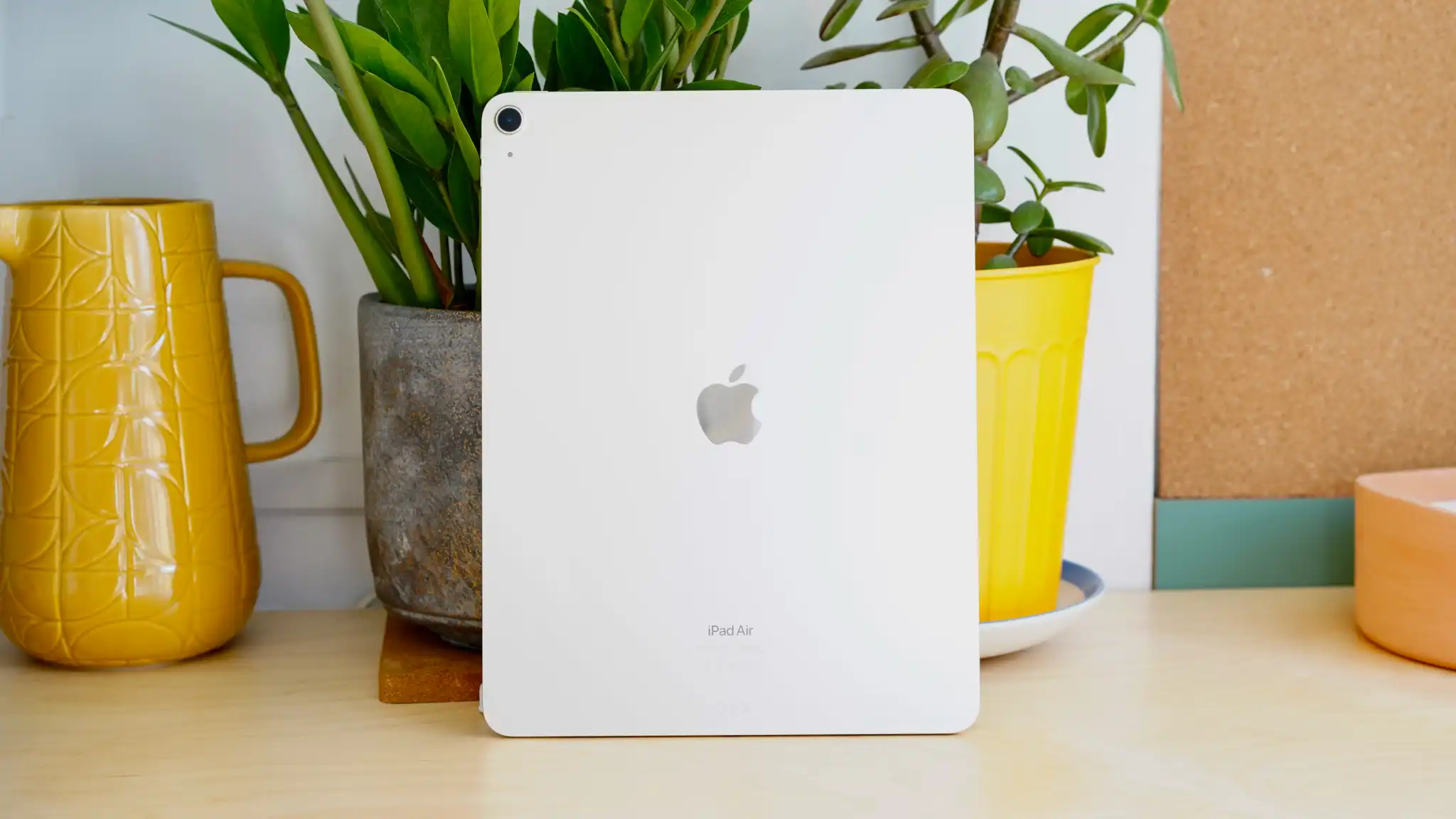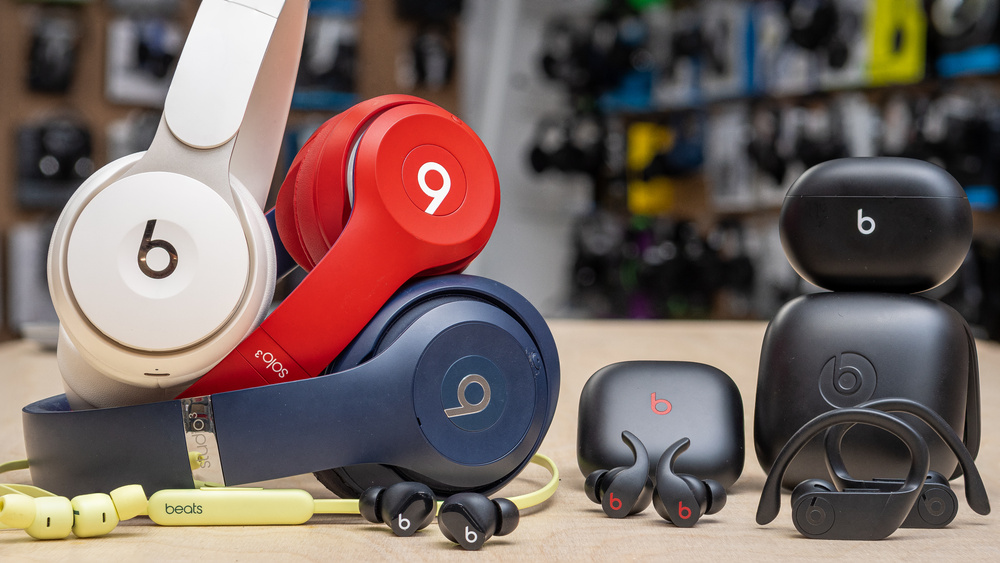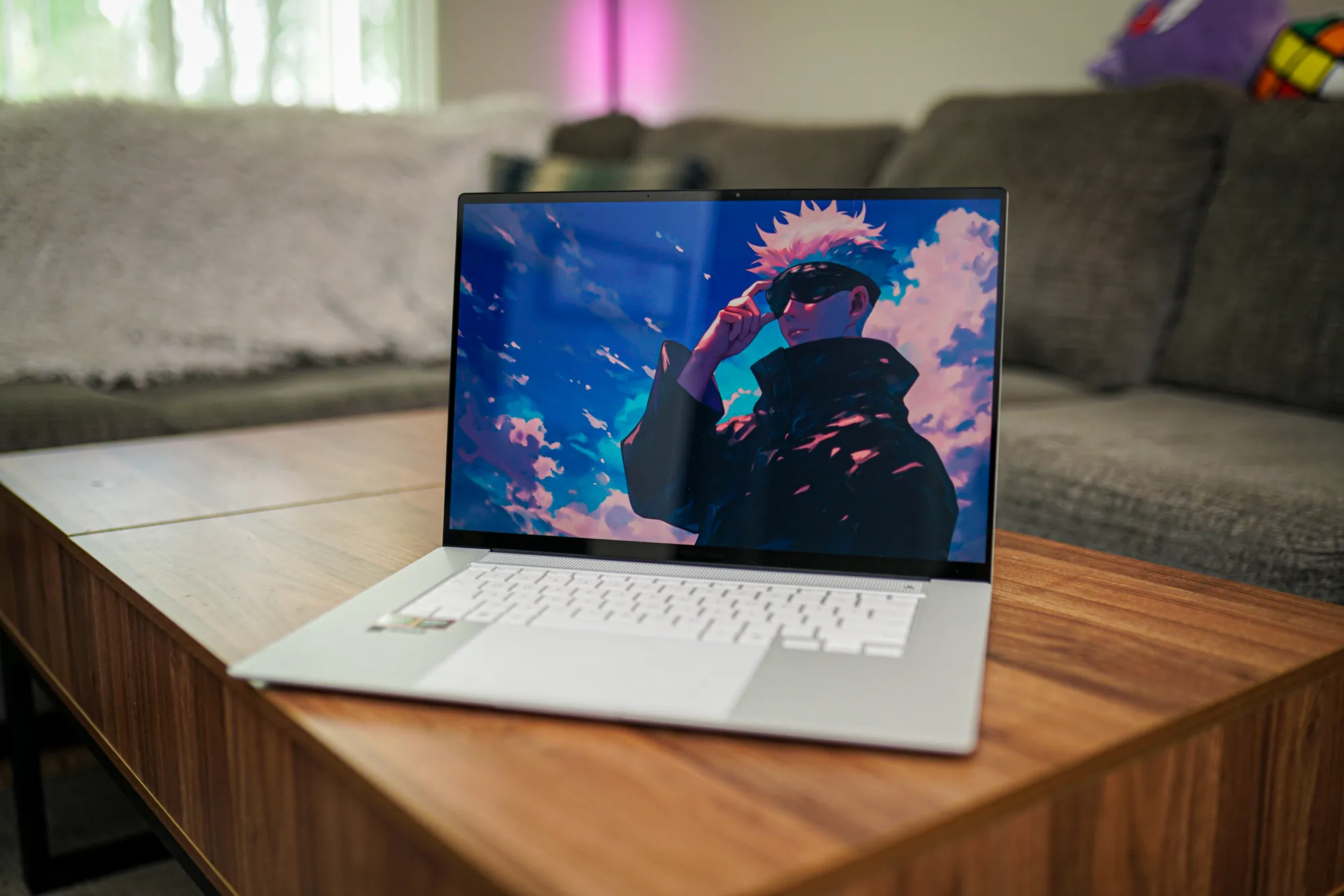Apple expands the horizons of its mid-range tablet brand
The sixth-generation iPad Air doesn’t look like much of an advancement at first glance, and except for one pretty sizeable addition (in more ways than one), it really isn’t.
This is the first example of Apple’s mid-range tablet range to feature a larger size option, however, which could make it the ideal Goldilocks choice for a certain type of tablet user.
It might not be the best or the cheapest iPad on the market, but it borrows a number of key attributes from the brilliant iPad Pro without commanding MacBook money. As it turns out, there’s considerable value in that.
I’m reviewing the larger 13-inch model here, but most of the comments will apply just as well to the ‘regular’ 11-inch model too. Size aside, the two tablets are broadly identical, but I’ll point out where there are differences as we go.
Design & Build
- It’s very much an iPad
- Thicker and heavier than equivalent Pro models
- Support for select Apple Pencil and Magic Keyboard accessories
Apple should probably rethink its tablet naming scheme, because there’s nothing airy about the new iPad Air. True, I’m covering the larger 13-inch model, which was always going to be bigger and heavier than its 11-inch predecessor, the iPad Air 5 (2022).
But at 280.6 x 214.9 x 6.1mm and 617g, it’s a real handful. More to the point, it’s both considerably thicker (by 1mm) and heavier (by 38g) than the equivalent iPad Pro 13 (2024).
The 11in model is similarly chunky compared to the smaller Pro, though it still comes in thinner and lighter than the iPad 10th gen (2022) at least.
Apple pretty much set the terms for contemporary tablet design (with a few notable exceptions), so complaining about this seems a bit silly, like griping about the design of a pencil

Otherwise, all you can really say about the iPad Air 13in (2024) design is that it’s an iPad. It looks a lot like those flanking models, with a thick but uniform screen bezel around front, an all-metal body, and a flat rim. Apple pretty much set the terms for contemporary tablet design (with a few notable exceptions), so complaining about this seems a bit silly, like griping about the design of a pencil.
It’s a beautifully built piece of kit, as we’ve come to expect. There’s a little flex to the body, but then it’s a huge expanse of aluminium. I didn’t feel like I would be damaging it in a hurry, but then this is a loan unit from Apple and I wasn’t going to push my luck.
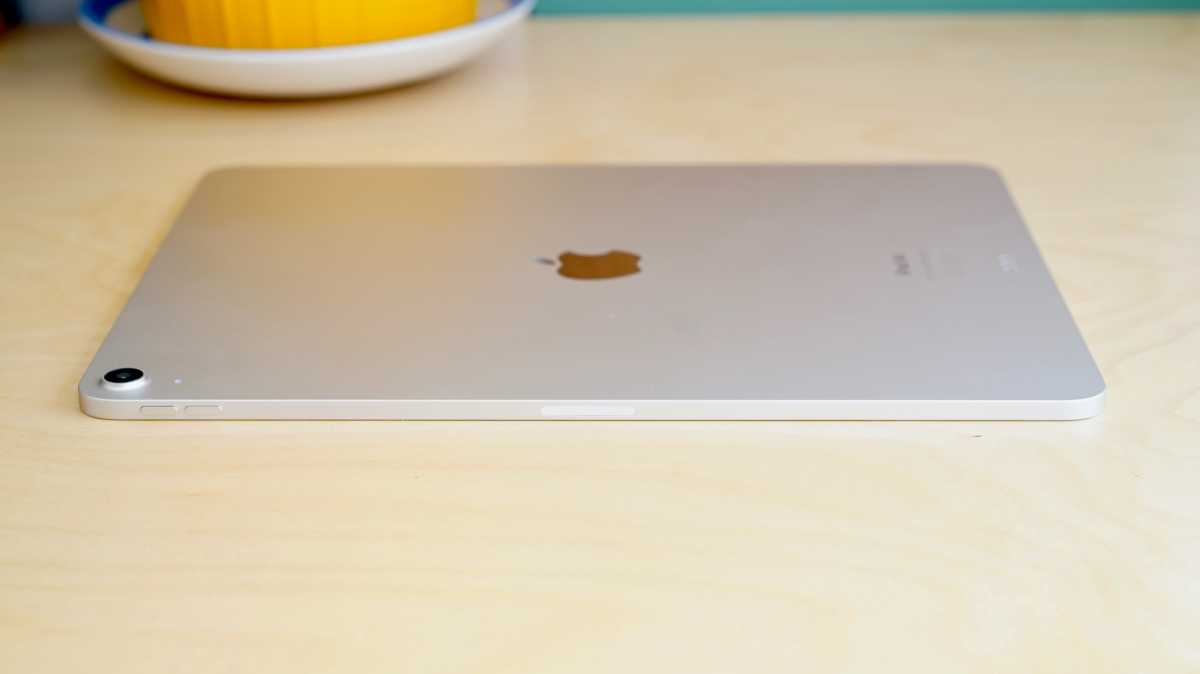
Jon Mundy / Foundry
My review model came in the tried and true Starlight colour, which is basically light grey, while Space Grey provides the standard darker option. Blue and Purple provide the more interesting options, though they’re both fairly pale metallic shades.
The hardware buttons are all situated close to one another, with the volume rocker to the left of the top edge, and the power button-cum-Touch ID sensor to the top of the left edge. Apple appears to have almost fully committed to considering landscape orientation the default now – though the rear iPad text suggests not quite – with the front-facing camera switching to the top landscape edge. This makes for way more natural video calls.
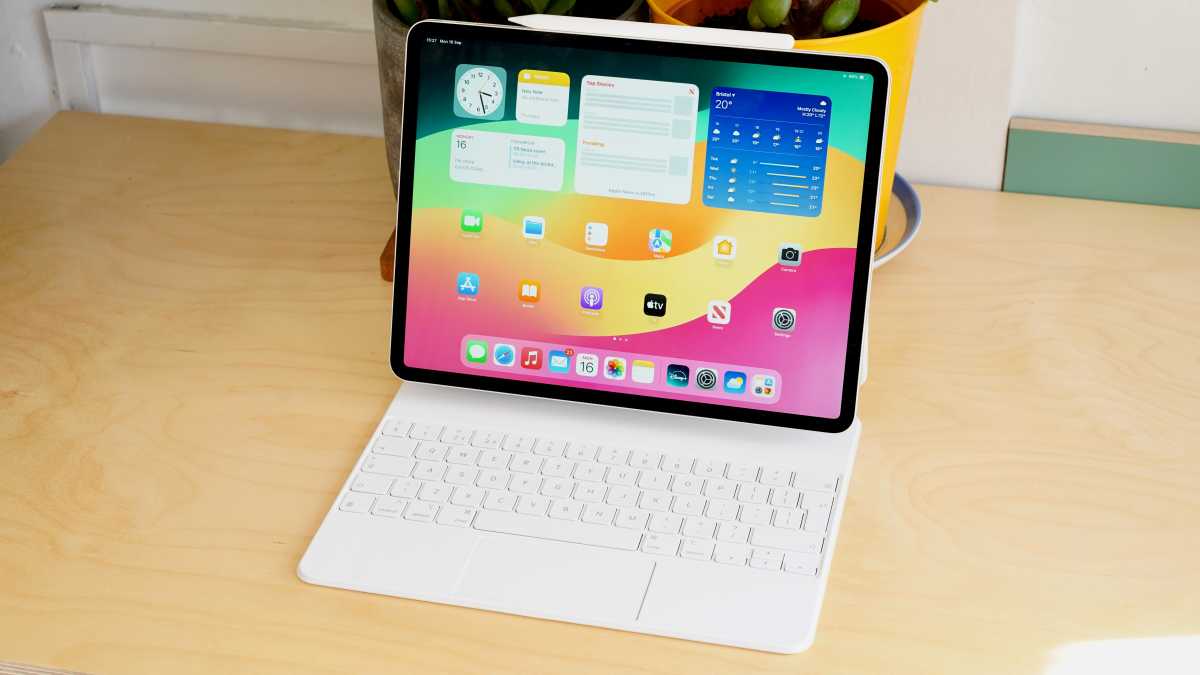
Accessory support is a little confusing here but can result in a fairly comprehensive – if pricey – setup. The iPad Air 13in (2024) is compatible with the Apple Pencil (USB-C) and the Apple Pencil Pro, but not the second-gen Apple Pencil. Meanwhile, it works with the same original Magic Keyboard case as the previous model, and not the latest revision so be careful when buying these things.
Both stylus and keyboard case are excellent accessories, and the latter in particular turns the iPad Air into an almost MacBook-like typing and navigation experience. I still wouldn’t take it over a MacBook Air for actually getting things done – the overall balance doesn’t make it as comfortable for literally working on your lap, while iPadOS still can’t match MacOS for productivity. But for word processing and other related light productivity tasks, it can stand in very well.
Screen & Speakers
- New 13-inch option a huge boon
- 600 nits and 2048 x 2732 on the 13in
- Still no 120Hz, which is a bit silly
The big news with the iPad Air (2024) is the provision of a new 13-inch display option, and the impact of that shouldn’t be downplayed.
This is by far the cheapest 13-inch device on Apple’s extended roster – £$500 cheaper than the iPad Pro 13 (2024), £$400 cheaper than the MacBook Air 13in (M3), and £$200 cheaper than the ageing MacBook Air 13in (M2).
It’s still not cheap at a starting price of £799/$799, but the 13-inch experience has major benefits for media consumption, sketching using the Apple Pencil, and more advanced productivity tasks that involve multi-tasking.
It lacks the outstanding pop of the latest iPad Pro and its two-layer AMOLED panel, with this once again being an IPS LCD. However, it remains an excellent screen, with a sharp 2048 x 2732 resolution and excellent colour accuracy.
Protect your new iPhone 16 and add a hidden built-in stand
By far my biggest issue with the iPad Air 13-inch screen is the continued lack of support for Apple’s 120Hz ProMotion standard

Meanwhile Apple’s stated typical brightness of 600 nits tallies with my own measurements. That’s strong for a non-Pro tablet, and works out to about 100 nits brighter than last year’s model. It should be noted that this is one area where the 13-inch model is clearly superior, as the 11-inch screen only hits 500 nits.
By far my biggest issue with the iPad Air 13-inch screen is the continued lack of support for Apple’s 120Hz ProMotion standard. It remains rooted to 60Hz, and as someone who uses nothing but 120Hz displays in their day to day life (phone, laptop, and even TV), I can quite clearly notice the difference – especially when the picture is blown up to full size right in front of my face.
There’s a clear lack of fluidity when flicking between home screens or scrolling through web text, and it’s rather jarring from a device that otherwise looks and performs in to a ‘Pro’ level.
In audio terms, Apple supplies just a pair of speakers for stereo sound in landscape content. Despite what the extra grilles might suggest, it doesn’t offer the supreme quad speaker depth of the iPad Pro range, but sound output remains crisp and clear regardless.
It’s more than up to the task of servicing the movie and TV streaming content playing on that huge screen when headphones aren’t an option.
Specs & Performance
- M2 processor
- 8GB RAM
- 128/256/512GB/1TB storage
There might be two years separating the iPad Air 6 and the iPad Air 5, but Apple has only moved the performance on a single generation, from the M1 chip to its M2 chip. That’s about it for any hint of disappointment though, because Apple’s custom silicon flies.
We were bowled over by the previous Air’s performance, and the latest model follows suit. Apple reckons that the M2 chip featured here, which packs an 8-core CPU and a 9-core GPU, is around 50% faster than the previous M1 model.
Apple’s custom silicon flies

It’s tricky to compare like for like in the tablet world, but I can say that the iPad Air 13in (2024) absolutely trounces the likes of the Samsung Galaxy Tab S9 Ultra and the OnePlus Pad 2 – two current premium Android tablets – in CPU terms, and matches its predecessor’s maxed out on-screen GPU results.
As before, that 60Hz display is a limiting factor when it comes to testing what this thing can do graphically. It’s reason enough to go Pro if that’s really what you’re after.
Even so, the iPad Air (2024) is a bit of a beast, and it’ll be able to handle regular tablet tasks like media consumption, multi-tasking and gaming with contemptuous ease. This is essentially laptop levels of power we’re talking about here, or indeed compact desktop power – the current Mac Mini also runs on a variant of this very same chip.
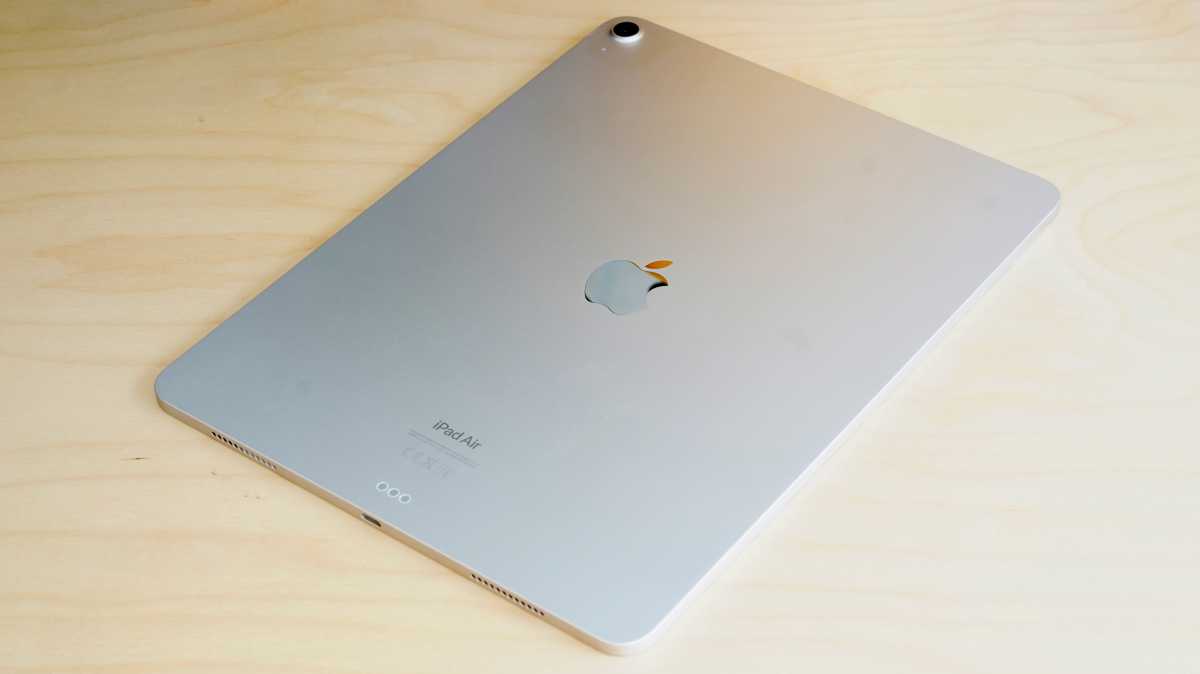
I still question whether this is overkill in a tablet, but it will come in handy if you’re someone who likes to edit photos or videos on the go. It also means that if you pair it with the aforementioned Magic Keyboard, the latest iPad Air feels even more like a 2-in-1 laptop. Together with 8GB of RAM (quite a lot for an iOS-based device), you’ll be able to hop in and out of apps without a stutter, and run apps side by side fluidly.
It will also ensure a fair amount of headroom, meaning that it should remain feeling fast and fluid for years to come – especially with Apple’s excellent ongoing software support.
For storage you can choose from 128-, 256, 512GB and 1TB capacities so there’s something for everyone.
You can also count on a speedy USB Type-C 3.1 Gen 2 port with data transfer speeds of up to 10Gbps, which is unchanged from the previous model. Another shared feature is the option of 5G connectivity, though of course you’ll need to pay extra for this. Wi-Fi 6E and Bluetooth 5.3 also come as part of the package.
I’ve mentioned it already, but you’ll have to make do with Touch ID for biometric authentications. Face ID remains a Pro-only experience in Apple’s iPad world.
Cameras
- Same 12Mp f/1.8 main camera
- Same 12Mp f/2.4 front camera
- Front camera repositioned for landscape use
Apple hasn’t made any improvements to the iPad Air 13in (2024)’s rear camera, meaning its the exact same 12Mp f/1.8 unit as before. Given our dim view on anyone using tablets to take anything other than illustrative or app-related snaps, this isn’t much of a criticism at all.
For what it’s worth, the iPad Air’s main camera takes perfectly serviceable snaps provided you feed it plenty of light. Apple’s image processing chops, earned through years of smartphone iteration, ensure as much even with such modest hardware.
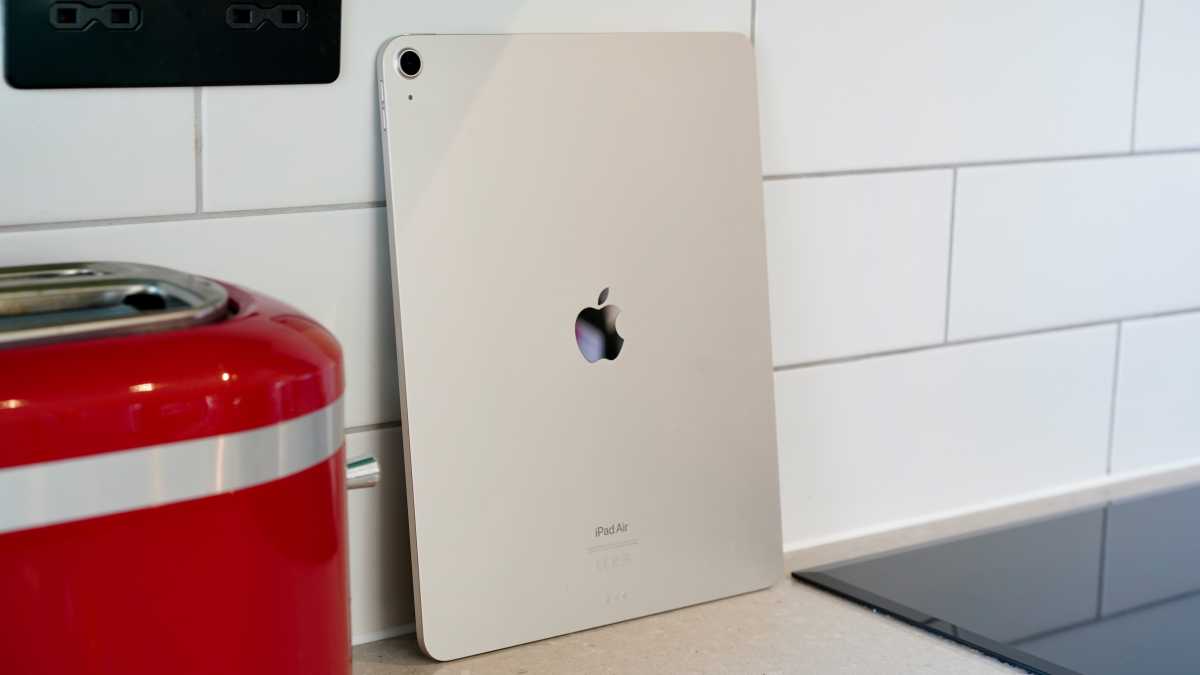
There hasn’t been any chance to the quality of the front camera either, which means that you get the same 12Mp f/2.4 sensor with the same ultra-wide 122-degree field of view. The latter enables the tablet to make use of Apple’s Center Stage feature, which keeps you in focus when you move around in video calls.
Where Apple has made a change for the better is by relocating this front camera to the longer edge of the tablet, making those video calls look much more natural – assuming you do them in landscape view. Which, let’s face it, you really should.
Battery Life & Charging
- 10340mAh battery
- 10 hours of sustained use
- 20W charging support (not in box)
Battery life hasn’t shifted with the move to the new generations of iPad Air, despite the new larger and brighter screen option, not to mention the switch to a new chip.
Apple is still claiming that you’ll be able to watch 10 hours of video on Wi-Fi out of a single charge, and as always that pretty much tallies with reality. In my own testing, an hour of watching a movie on Disney Plus, with the display set to 50% brightness, sapped about 9% of a charge.
This is ostensibly one of Apple’s more casual tablets, of course, and the average use case scenario will be much less intensive. In more regular use, the latest iPad Air performs admirably, aided by some typically excellent standby stamina.
I took the iPad Air 6 off charge on the Wednesday morning, and by the Saturday morning it still had 41% left in the tank
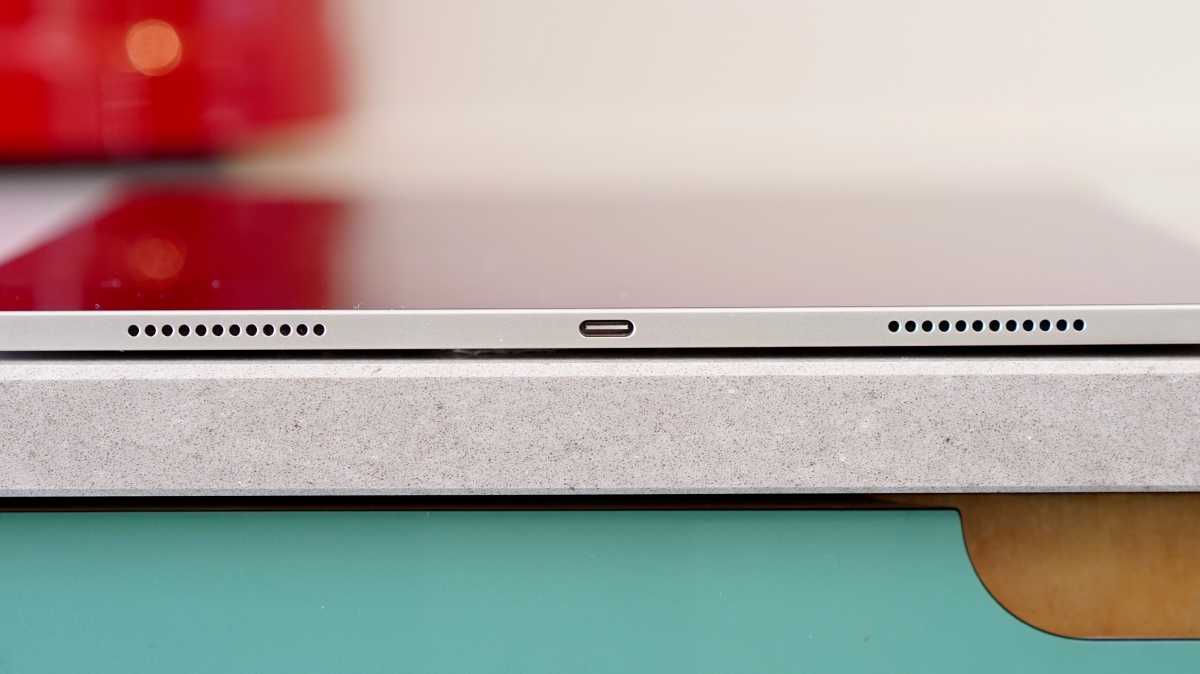
Anecdotally, I took the iPad Air 6 off charge on the Wednesday morning, and by the Saturday morning it still had 41% left in the tank. It eventually ran out at around lunch time on the Sunday. This was with several hours of casual game playing and around an hour of Netflix watching, interspersed by some light web browsing.
Charging speeds remain somewhat underwhelming. You don’t get a charger in the box of course, but it will go up to 20W with an appropriate USB-C power adapter. With this new larger model, a 15 minute charge from empty only got it to 16%, while a 30 minute charge got it to 31%. It took just shy of 2 hours for a full charge.
That’s pretty slow in smartphone terms, but pretty typical for a tablet. The OnePlus Pad 2 hits 19% in 15 minutes, while the Samsung Galaxy Tab S9 Ultra hits 13% in the same time.
Software & Apps
- Originally shipped with iPadOS 17
- Now updating to iPadOS 18
- Still the best tablet OS around
The iPad Air (2024) initially shipped with iPadOS 17, but right at the end of our review period iPadOS 18 rolled out. It doesn’t bring with it Apple’s hotly anticipated Apple Intelligence AI features (they’re set to start appearing in October in the USA), but there are several additions and enhancements that keep this the best tablet OS in the game.
At long last we get a native Calculator app (no really), and in true Apple style, it has made up for arriving mystifyingly late by going the extra mile. Bring an Apple Pencil into play and the Math Notes feature will let you sketch out complex maths problems, with Apple’s software magically solving them.
an increasingly enhanced and super-sized take on iOS that’s fundamentally ideal for consuming media, surfing the web, and running apps in a more data-rich and involving fashion
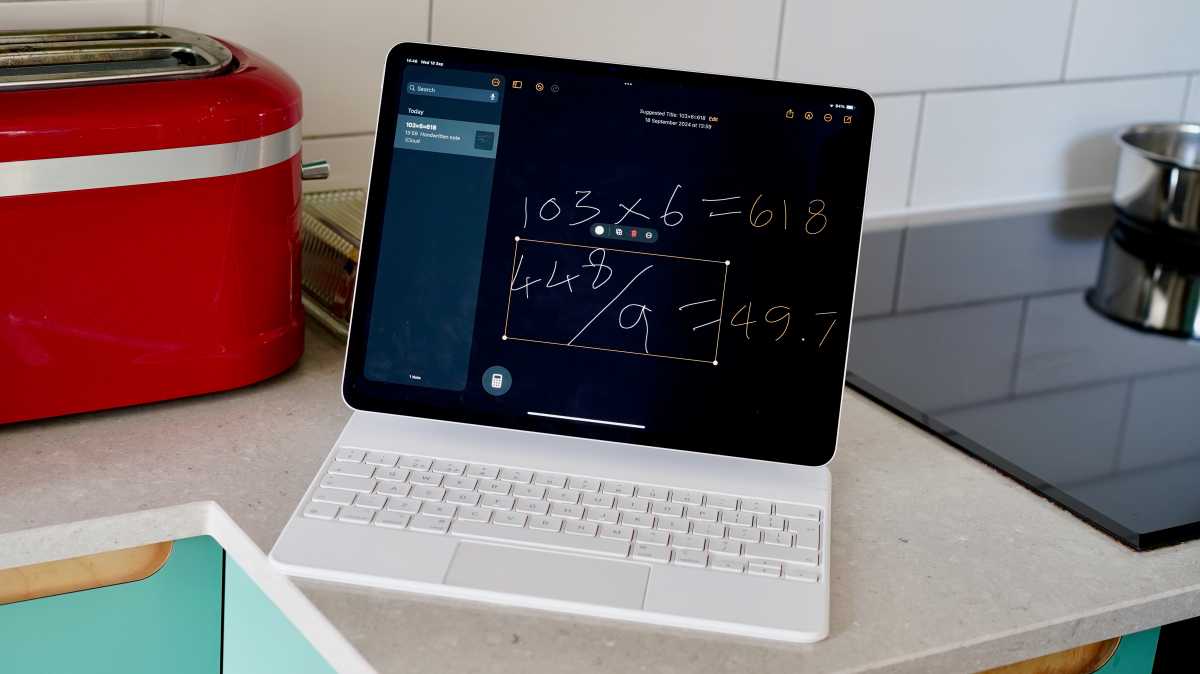
Handwritten notes in the Notes app have also been buffed with Smart Script, which can tidy up your scruffy handwriting, add space, and merge in typed text, among other things.
More generally, you’re now free to place app icons where you like without Apple automatically closing up any spaces, and you can also customise the look of said icons. Control Centre has gotten more powerful too, with a new tabbed layout and deeper customisation potential.
These enhancements are nice, but iPadOS remains the same at heart. That is, an increasingly enhanced and super-sized take on iOS that’s fundamentally ideal for consuming media, surfing the web, and running apps in a more data-rich and involving fashion.

As good as iPadOS is as a tablet OS, however, it still isn’t up to the task of replacing a bog standard MacBook with MacOS for productivity tasks.
Apple’s customisation enhancements in iPadOS 18 are neat, but they’re just playing around the edges. Sure, you can drag and drop files between multiple open apps, but doing such things isn’t as fundamental or tightly integrated as on MacOS – or Windows for that matter.
Stage Manager helps to close that gap, producing a more Mac-like interface with floating resizable app windows. But it’s still far from a seamless or intuitive experience, and Apple still doesn’t make this the default UI standard, reflecting the uncertain ‘tweener nature of modern iPadOS.
Personally, I never expected or even wanted iPadOS to emulate MacOS in this way. I’m happy to keep the tablet experience as a more casual interstitial one, somewhere in between smartphones and laptops, but closer to the former. Those who dream of a proper Apple 2-in-1, however, will need a few more sleeps before that becomes a reality.
Price & Availability
The iPad Air 13in (2024) has the biggest range of pricing we’ve ever seen from the Air range. It’s all thanks to this new bigger size option, in addition to a healthy spread of storage and cellular variants.
We’re talking about a vast spread from just £599/$599 for the 128GB 11in Wi-Fi model, right up to a whopping £1,449/$1,449 for the 1TB 13-inch Cellular model. That’s from Apple’s website, but both are going even cheaper on Amazon at the time of writing.
You’ll pay a £200/$200 premium to upgrade from 11- to 13-inch, with the larger model pricing starting from £799/$799. The model Apple sent me to review is the 13-inch 512GB Wi-Fi model, which costs a still not inconsiderable £1,099/$1,099.
As such, it pays to break down the new iPad Air’s value proposition. Overall, right now in late(ish) 2024, it seems pretty darned good.
That 11-inch starting price sounds mighty tempting and is probably the iPad most casual or light users should go for at the time of writing. Sure, the regular iPad (2022) can be had for around £150/$150 less, but it features a fairly old non-M-series chip and half the storage, and is due for a replacement.
That starting price for the 13-incher also looks tempting when you consider it as a viable alternative to the 13-inch iPad Pro, which starts from an eye-watering £1,299/$12,99. The main perceptible advantage in going Pro is its frankly gorgeous OLED display, but is that worth £500/$500 to you? It might be.
I’d take the latest iPad Air, in whatever iteration, over any similarly priced or even slightly cheaper Android tablet, no questions asked. Apple’s tablet ecosystem is simply much better fleshed out and cohesive than Google’s, and its M-series chip performance slays the opposition.
You can buy the iPad Air from Apple, Amazon, Currys, John Lewis, Argos and other retailers in the UK.
In the US, look to Apple, Amazon and BestBuy.
Check out our rankings of the best tablets you can buy for more options.
Should you buy the iPad Air 13in (2024)?
The iPad Air 13in (2024) covers more ground than any previous Air tablet, and is probably the iPad family most people should be looking to choose from. It delivers a new Pro-like 13in display option, near-Pro performance from Apple’s M2 chip, a timelessly solid design, and decent accessory compatibility.
Pricing varies hugely, meaning you really do need to consider what you want from your tablet in terms of display size, storage capacity, and connectivity. Where the Air starts overlapping with the Pro’s pricing, you have to consider whether the step up model’s phenomenal display, superior power, and advanced accessory options make it a better buy.
At the entry point of the new iPad Air range, however, it’s difficult to argue with it being the best all-round super-sized tablet for most people. It’s a slick, powerful tool for casual media consumption and light productivity tasks, and much like the outgoing model, nothing else really comes close unless you’re willing to pay a lot more to go Pro.
Specs
- iPadOS 18
- 13in, 2048 x 2732, IPS LCD, 60Hz display
- Side-mounted fingerprint sensor
- Apple M2
- 8GB RAM
- 128GB/256GB/512GB/1TB storage
- 12Mp, f/1.8 main camera
- Up to 4K @ 60fps rear video
- 12Mp front-facing camera
- Stereo speakers
- 5G (optional)
- Wi-Fi 802.11 a/b/g/n/ac/6E
- Bluetooth 5.3
- 10340mAh battery
- 20W charging (not supplied)
- 280.6 x 214.9 x 6.1mm
- 617g
- Launch colours: Space Gray, Starlight, Purple, Blue

